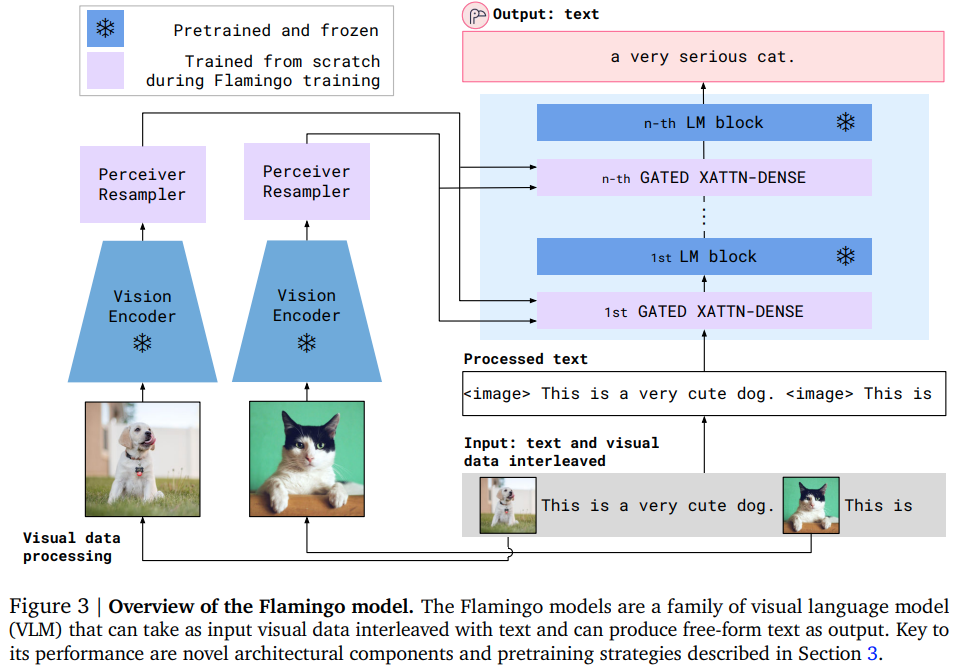
Implementação do Flamingo, pergunta visual de última geração que responde à rede de atenção, em Pytorch. Incluirá o reamostrador do percebedor (incluindo o esquema onde as consultas aprendidas contribuem com chaves/valores a serem atendidos, além de incorporações de mídia), os blocos especializados de atenção cruzada mascarados e, finalmente, o tanh gating nas extremidades da atenção cruzada + blocos feedforward correspondentes
Apresentação de Yannic Kilcher
$ pip install flamingo-pytorch import torch
from flamingo_pytorch import PerceiverResampler
perceive = PerceiverResampler (
dim = 1024 ,
depth = 2 ,
dim_head = 64 ,
heads = 8 ,
num_latents = 64 , # the number of latents to shrink your media sequence to, perceiver style
num_time_embeds = 4 # say you have 4 images maximum in your dialogue
)
medias = torch . randn ( 1 , 2 , 256 , 1024 ) # (batch, time, sequence length, dimension)
perceived = perceive ( medias ) # (1, 2, 64, 1024) - (batch, time, num latents, dimension) Em seguida, você insere o GatedCrossAttentionBlock em intervalos diferentes em seu modelo de linguagem gigante. Seu texto atenderia então à mídia percebida de cima
A maneira recomendada de derivar o tensor booleano media_locations seria alocar um ID de token especial para a mídia e, em seguida, no início de seu modelo de linguagem grande, fazer media_locations = text_id == media_token_id
import torch
from flamingo_pytorch import GatedCrossAttentionBlock
cross_attn = GatedCrossAttentionBlock (
dim = 1024 ,
dim_head = 64 ,
heads = 8
)
text = torch . randn ( 1 , 512 , 1024 )
perceived = torch . randn ( 1 , 2 , 64 , 1024 )
media_locations = torch . randint ( 0 , 2 , ( 1 , 512 )). bool ()
text = cross_attn (
text ,
perceived ,
media_locations = media_locations
)É isso!
Atenção é tudo que você precisa.
Integração com PaLM
Primeiro instale vit-pytorch para o codificador de visão
$ pip install vit-pytorchEntão
from vit_pytorch . vit import ViT
from vit_pytorch . extractor import Extractor
vit = ViT (
image_size = 256 ,
patch_size = 32 ,
num_classes = 1000 ,
dim = 1024 ,
depth = 6 ,
heads = 16 ,
mlp_dim = 2048 ,
dropout = 0.1 ,
emb_dropout = 0.1
)
vit = Extractor ( vit , return_embeddings_only = True )
# first take your trained image encoder and wrap it in an adapter that returns the image embeddings
# here we use the ViT from the vit-pytorch library
import torch
from flamingo_pytorch import FlamingoPaLM
# a PaLM language model, the 540 billion parameter model from google that shows signs of general intelligence
flamingo_palm = FlamingoPaLM (
num_tokens = 20000 , # number of tokens
dim = 1024 , # dimensions
depth = 12 , # depth
heads = 8 , # attention heads
dim_head = 64 , # dimension per attention head
img_encoder = vit , # plugin your image encoder (this can be optional if you pass in the image embeddings separately, but probably want to train end to end given the perceiver resampler)
media_token_id = 3 , # the token id representing the [media] or [image]
cross_attn_every = 3 , # how often to cross attend
perceiver_num_latents = 64 , # perceiver number of latents, should be smaller than the sequence length of the image tokens
perceiver_depth = 2 # perceiver resampler depth
)
# train your PaLM as usual
text = torch . randint ( 0 , 20000 , ( 2 , 512 ))
palm_logits = flamingo_palm ( text )
# after much training off the regular PaLM logits
# now you are ready to train Flamingo + PaLM
# by passing in images, it automatically freezes everything but the perceiver and cross attention blocks, as in the paper
dialogue = torch . randint ( 0 , 20000 , ( 4 , 512 ))
images = torch . randn ( 4 , 2 , 3 , 256 , 256 )
flamingo_logits = flamingo_palm ( dialogue , images )
# do your usual cross entropy lossÉ bastante evidente para onde tudo isso vai levar se você pensar além das imagens.
Para correção factual, imagine onde esse sistema estaria se alguém usasse um modelo de linguagem de recuperação de última geração como base.
@article { Alayrac2022Flamingo ,
title = { Flamingo: a Visual Language Model for Few-Shot Learning } ,
author = { Jean-Baptiste Alayrac et al } ,
year = { 2022 }
} @inproceedings { Chowdhery2022PaLMSL ,
title = { PaLM: Scaling Language Modeling with Pathways } ,
author = {Aakanksha Chowdhery and Sharan Narang and Jacob Devlin and Maarten Bosma and Gaurav Mishra and Adam Roberts and Paul Barham and Hyung Won Chung and Charles Sutton and Sebastian Gehrmann and Parker Schuh and Kensen Shi and Sasha Tsvyashchenko and Joshua Maynez and Abhishek Rao and Parker Barnes and Yi Tay and Noam M. Shazeer and Vinodkumar Prabhakaran and Emily Reif and Nan Du and Benton C. Hutchinson and Reiner Pope and James Bradbury and Jacob Austin and Michael Isard and Guy Gur-Ari and Pengcheng Yin and Toju Duke and Anselm Levskaya and Sanjay Ghemawat and Sunipa Dev and Henryk Michalewski and Xavier Garc{'i}a and Vedant Misra and Kevin Robinson and Liam Fedus and Denny Zhou and Daphne Ippolito and David Luan and Hyeontaek Lim and Barret Zoph and Alexander Spiridonov and Ryan Sepassi and David Dohan and Shivani Agrawal and Mark Omernick and Andrew M. Dai and Thanumalayan Sankaranarayana Pillai and Marie Pellat and Aitor Lewkowycz and Erica Oliveira Moreira and Rewon Child and Oleksandr Polozov and Katherine Lee and Zongwei Zhou and Xuezhi Wang and Brennan Saeta and Mark Diaz and Orhan Firat and Michele Catasta and Jason Wei and Kathleen S. Meier-Hellstern and Douglas Eck and Jeff Dean and Slav Petrov and Noah Fiedel},
year = { 2022 }
}